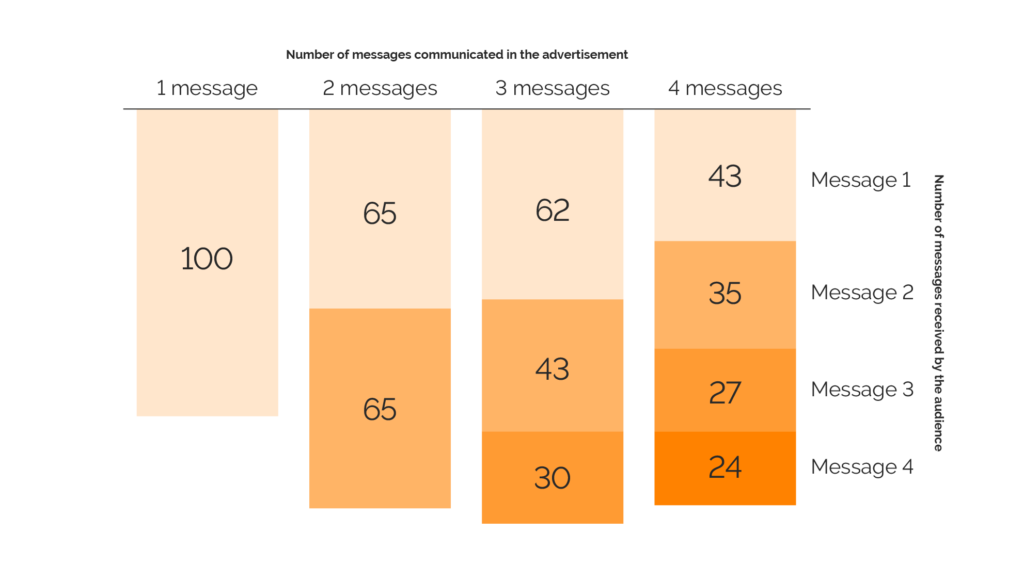How to get attention with B2B audiences using the SURE framework
Getting attention from a senior B2B audience is tough. Today, audiences are bombarded with content and advertising across multiple channels, and it is easier than ever for them to shut out unwanted messages and avoid your attempts to influence them.
So how do you get the audience’s attention in the first place? To stand a chance, your content needs four vital features, which we call the SURE framework. You need to make it simple, urgent, relevant and eye-opening.
In this post, we explain how to apply each of these essential ingredients and provide examples of where they’ve been used to great effect.
1. Simple
Too much content tries to communicate overly complex messages. Its producers assume that this makes them look clever and authoritative, and that they have a lot to say. In fact, the more messages you try to land with the audience, the less successful you are likely to be.
Kantar Millward Brown’s Link database, which tests the effectiveness of different advertisements, found that the more messages an ad tries to communicate, the lower the likelihood of any single message landing. Try to get one message across, and you could achieve 100% success if people engage with it. Try to communicate four, and only 43% will pick up your first message – and this falls to 24% for your fourth (see diagram).
Content is no different: to stand any chance of grabbing the attention of your time-poor audience, you need to keep the message simple.
SURE in action
McKinsey’s The 1.5 Degree Challenge is an example of simplicity in action. Its message is clear and can be summarised in one sentence: the content explores what the global economy needs to do to keep global warming below 1.5 degrees. Yet beneath this simple overarching message, there is considerable detail for those readers who want to explore more deeply.

If you want people to remember your key message, you are better off communicating one message – not two or more. Analysis of the Link database shows that the more messages you try to communicate, the less likelihood there is of any landing.
2. Urgent
When you start a marketing campaign, ask yourself: “why now?”. There has to be a reason for the audience to engage with your content, and they are more likely to do so if the change you are proposing is urgent. Humans are inherently short-termist, so anything that delivers quick results or protects from immediate losses will always grab our attention.
It is important to consider how you frame urgent messages. Behavioural economics tells us that losses loom larger than gains, so messages that emphasise the costs of not doing something instead of the benefits of doing something can instil a greater sense of urgency.
Peter Salovey, president of Yale University and an originator of the concept of emotional intelligence, argues that the framing of urgent messages should vary depending on whether the proposed change in behaviour is safe or risky. If our audience is likely to think the change is safe, then we should emphasise all the gains that will come from making it. If our audience thinks the change is risky, then they are more likely to be comfortable with the status quo, so the benefits of change are less attractive. That is when it is better to emphasise the bad things that will happen if there is no change (From Originals: How Non-Conformists Move the World, Adam Grant (2016)).
This has important implications for B2B marketing. Most of the time, we are asking our audiences to make significant – and therefore risky – investments or changes to their businesses: invest in AI and automation; accelerate digital transformation; or set ambitious net zero targets. Salovey’s research suggests that in these instances we are better off focusing on the costs of doing nothing than on the benefits of changing.
SURE in action
Accenture’s CFO Now: Breakthrough speed for breakout value explains how finance leaders must harness technology to enable decision-making at the pace required for today’s business environment. They face being left behind if they cannot become architects of business value and catalysts of digital strategy.
3. Relevant
Getting someone’s attention with your content means answering their questions and offering something of value. Relevant content answers the pressing questions and is as targeted, timely and tailored as possible.
To be relevant, you have to know your audience intimately. There is no point guessing what your audience cares about, or – even worse – projecting your worldview on to them in the hope that your message lands. Instead, you need to find out what matters to them and ensure that you match the right message with the right audience.
This means striking a careful balance between reach and relevance. Many content producers want as many people as possible to consume their content, but that is not always wise. In aiming for reach, you can end up sacrificing relevance because your content’s appeal is too broad.
Relevant content will also satisfy the audience’s curiosity. Defined by behavioural economist George Loewenstein as “the gap between what we know and what we want to know”, curiosity propels the audience forward until they find the information they want.
SURE in action
In EY’s Better Questions approach to content, each piece starts with a question rather than a statement. It is a great example of relevance based on stimulating curiosity. For example, its recent CEO Imperative report starts with the question “How can today’s leaders realize tomorrow’s opportunities?” This draws in the reader, creates curiosity and positions EY as helping to address business leaders’ most pressing problems.

4. Eye-opening
Unexpected messages secure the audience’s attention because they distort our models of reality. This is known in psychology as the Von Restorff effect, which describes the tendency to remember more easily anything that stands out or is unusual. Consider the famous Cadbury’s ad from 2007, which shows a gorilla drumming along to Phil Collins’s In the Air Tonight.

Cadbury’s marketing director Phil Rumbol had a difficult job persuading management that this would help to sell chocolate. After all, the ad was 90 seconds long, had no pictures of chocolate or anyone eating it, and only mentioned the brand at the very end. This ran counter to all established views about how advertising works. Yet when the ad was finally approved and aired, it led to a 10% increase in sales for Cadbury’s and was later voted the UK’s favourite ad. Why? Because it was surprising and memorable.
You may not want drumming gorillas in your B2B content, but the same principle applies. Put forward a surprising message, and you will be much likelier to grab your audience’s attention and be remembered.
SURE in action
Philips’ The Longest Night is a powerful and unexpected piece of emotional storytelling. To promote Philips’ innovative sleep aids, the video tells the story of an Icelandic fisherman struggling with insomnia.






 Back
Back

 Book a meeting
Book a meeting
 Book a meeting
Book a meeting


